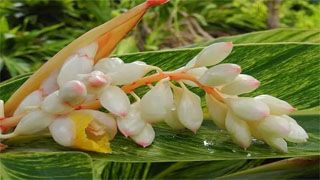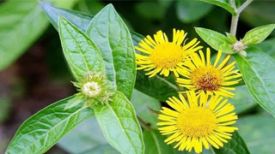
1. Aliases
White cardamom, white cardamom, round cardamom, white cardamom kernel, multiple bones, shell cardamom, and glutinous rice.2. Plant morphology
Perennial clustered herbaceous plants. The rhizomes are creeping and robust. Leaves 2-row, leaf sheath edge papery or membranous, hairless; The tip of the leaf tongue is round and hairless; Almost no petiole; Leaf blade lanceolate, apex pointed, base wedge-shaped, both sides hairless. The inflorescence is extracted from the rhizome and often partially covered in the soil; Inflorescence obovate to obconical, earthy yellow, apex circular to truncate; The bracts are oval shaped, papery, with thin edges and sparse long soft hairs. There are 10-15 concave longitudinal veins on the surface, and the apex is blunt; Flowers borne in bracts and axils; Bracteoles white, tubular; Calyx tubular, white, covered with micro hairs, apex 3-toothed; The corolla tube is slightly longer than the calyx tube, white, narrowly elliptical; The lip is oblong to obovate in shape, white in color, with a rounded or nearly flat apex. The middle rib is slightly thickened, and the apex is often orange in color; Lateral degenerate stamens, subulate; The filaments are wide and grooved, and the connective appendages are 3-lobed; Nectar gland 2, semi cylindrical; Ovary inferior, covered with hair. Capsule soil yellow or intermittently brownish red, nearly spherical, with 3 edges, pubescent, apex obtuse, and persistent perianth. The seeds are polygonal, brownish red, and fragrant. The flowering period is year-round, with a peak flowering period from April to June and a fruiting period from July to August.
3. Origin distribution
Born in valleys or damp areas under forests. In China, it is mostly cultivated in sparse forests or under shade sheds. Originating from Indonesia. Currently, there is cultivation in Hainan, China.
4. Harvesting and processing
Collect fruit spikes from July to August when the fruits are about to ripen but not yet cracked, remove any remaining floral covers and fruit stalks, and then dry them in the sun; Alternatively, sulfur yellow can be used to fumigate and bleach the fruit skin, resulting in a yellow white color.
5. Characteristics of medicinal herbs
Class spherical. The surface is yellow white to light yellow brown, with deep longitudinal grooves, a protruding style base at the top, concave fruit stalk marks at the base, and light brown hairs at both ends. The fruit skin is light, brittle, and prone to longitudinal cracking. The seeds are irregularly polyhedral, with a slightly raised back and a dark brown surface with wrinkles, and are covered with residual pseudoderm. The aroma is fragrant, and the taste is spicy and cool, slightly like camphor. Indonesian cardamom is slightly small, with a yellow white surface and some showing a slight purple brown color. The fruit skin is thin, the seeds are thin and shriveled, and the odor is weak.
6. Nature, taste, and meridian tropism
Warm in nature and spicy in taste. Guipi Meridian and Stomach Meridian.
7. Effect and function
Relieve dampness and distension, promote qi circulation and warm the middle, and stimulate appetite and digestion. Belongs to the category of dehumidifying drugs.
8. Clinical applications
Dosage 3-6 grams, it is advisable to add the decoction and then pour it down; Or into pills or powder. Used to treat dampness and turbidity, lack of appetite, initial onset of dampness and warmth, chest tightness without hunger, cold dampness and nausea, chest and abdominal distension and pain, and persistent food accumulation.
9. Pharmacological research
Cardamom can enhance the therapeutic effect of low-dose dihydrostreptomycin on experimental tuberculosis in guinea pigs.
10. Chemical composition
Cardamom mainly contains volatile oil, as well as eucalyptol, a-pinene, p-pinene, camphor, laureene, syringene, etc.
11. Taboos for use
Those with yin deficiency and blood dryness are prohibited from taking it.
12. Compatibility prescription
① Treating bloating and vomiting in the stomach: 3g of white cardamom, 6g of patchouli, 4.5g of pinellia ternata and tangerine peel each, and 6g of ginger. Boiled in water. (National Compilation of Chinese Herbal Medicine)
② Treating stomach coldness for a long time: 3 grams of agarwood, 3 grams of white cardamom, and 3 grams of Su Ye each, with a total of the top being the end. Take 2.1 grams of persimmon root soup per serving. (The Secret Classic of Longevity)
③ Treatment for pregnancy vomiting: 3g of white cardamom, 9g of bamboo mushroom, and 3 pieces of jujube. Crush the ginger and extract the juice. Take 3 herbs and decoct them into 1 teacup (50-60 milliliters). Filter and take the ginger juice. [Wuhan Medical and Health Journal 1959, (3): 288]
④ Postpartum hiccup treatment: 15 grams of white cardamom and 15 grams of clove each. Study in detail. Take 3 grams of peach kernel soup, take a small amount of water before taking. ("The Secret of Qiankun")
The content of the article is for clinical reference only. Non professionals in traditional Chinese medicine are not allowed to try medication.


